February 7th is an important day in chemistry and science – it marks the publication of the first attempt at organizing the known elements. Two weeks ago our young scientists celebrated the day in science classes with activities related to the periodic table of elements. It was a fabulous day of learning.
On that February day in 1864, British chemist John Newlands published the first periodic table with elements organized by their increasing masses, five years later Russian chemist Dimitri Mendeleev created the framework which became the periodic table of elements which is familiar to many of us.

I remember high school and college chemistry and I wish I knew then what I know now about the periodic table of elements.
Students were encouraged to join in the celebration by dressing up as an element and many did.
In my classes we celebrated by learning a few interesting facts about the world around us.
-
-
-
-
- All living things – plants and animals – are almost entirely made up of four elements: hydrogen, oxygen, carbon, and nitrogen. Other essential elements include phosphorus, sulfur, calcium, magnesium, potassium, iron, and other minerals and metals
- The universe is 92% hydrogen and 8% carbon (rounded to the nearest whole number) with less than 0.5% of the matter of the universe consisting of the remaining 90 naturally occurring elements.
-
-
-
The day is a perfect fit with our new unit, How Can I Smell Things from a Distance? The unit exposes middle school science students to particles, states of matter, and phase changes. We will learn that everything in our world is made up matter or particles and those particles have certain properties.
We have already begun developing a model of what a smell looks like, and we’ve established that air has mass, weight, and volume – key scientific concepts which are building blocks for scientific understanding. We have much more to learn in the coming weeks about gases, properties of matter, and more.
As for February 7th, we finished each class period playing a game of Periodic Table bingo, or A-T-O-M-S where the calls were A – oxygen, instead of A-8! Students had to navigate the periodic table to complete their A-T-O-M-S cards. It was a fun day and students reflected on their learning by sharing what they learned and their noticings and wonderings. Below are a few of the comments left by our young scientists.
-
-
- I learned that everything in the world is made out of atoms.
- That H12, C22, O11 makes sugar
- that i am 99 percent made up of 4 elements
- How each and every number is labeled by an atomic number (I learned the name of that)
- What the atomic number means.
- I wonder how all of this stuff was figured out by scientists, and how all the elements were discovered.
- Why is gold Au on the periodic table?
- and much more….
-
I look forward to the next few weeks as I guide our young scientists through more discoveries and how it relates to the world. Also, I look forward to sharing more on Semper Sharkus about how sixth grade science is moving forward.
A shark is curious and full of wonder. Semper sharkus, once a shark, always a shark.








